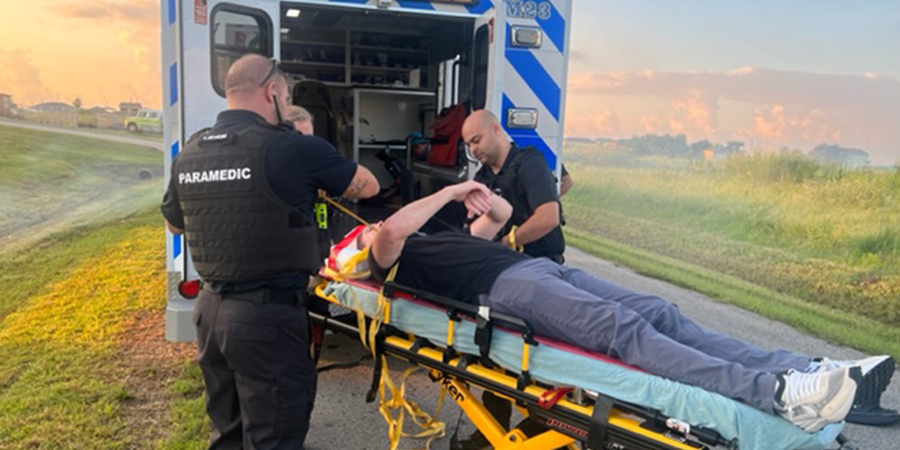When a vehicle struck a Galveston County Sheriff’s Office deputy during Jeep Weekend this summer in Crystal Beach, EMTs took immediate action.
The medics of Galveston County Emergency Services District No. 2 (GCESD2) treated and stabilized the deputy for a quick helicopter ride across the water to the UTMB emergency room in Galveston.
Doug Saunders, manager of the EMS crew for the district that covers the Bolivar Peninsula, watched nine of his medics work in the back of an ambulance with efficient, organized and focused moves.
“I’ve been doing this for 31 years, and he (the deputy) received injuries that were–let’s just say that’s the most injuries I’ve seen for one person in 31 years,” Saunders said. “From the time they called for assistance, he was at UTMB within 19 minutes.”
A helicopter from PHI Air Medical Ellington was standing by at the Crystal Beach Fire Department, not far from the middle-of-the-night accident scene.
“Nobody was trying to be the hero that night,” Saunders said. “If you had seen the injuries, you would have said it’s not going to be positive. But it was a positive outcome— it was phenomenal.”
The district funds the emergency medical services and the three volunteer fire departments on the Bolivar Peninsula: Crystal Beach, High Island and Port Bolivar. The EMS component was previously called Peninsula EMS.
“An hour and eight minutes is the average patient contact time for our medics,” Saunders said. “And 90 percent of our patients are transported to UTMB.”
Those patients often get to UTMB on a GCESD2 ambulance that rides on the Galveston-Port Arthur Ferry. The Texas Department of Transportation operates the free ferry as an extension of Highway 87.
On average, it takes the ferry 18 minutes to cross the 2.7 miles to Galveston Island from the peninsula. Loading time can take 9 minutes. And the wait time can be 45 minutes or longer depending on traffic and the season.
“We can call ahead if we know we have a priority patient,” Saunders said. The ferry crew can hold a trip for an ambulance.
The district also has to consider the possibility of a ferry losing propulsion during a ride or the choppiness of the water in the Ship Channel. If the water is extremely choppy, it might not be the best option for some passengers who are already sick or injured.
Another challenge is the dominance of elevated structures that have been constructed on the peninsula.
“About 80 percent of our patients are on an elevated structure,” Saunders said. “We use the stair chair and other ways to get them down that normal agencies don’t have to use on a daily basis. When we get a 911 call, it’s a two-unit response even when we don’t know what type of call it is, just because of the stairs involved.”
On average, elevated structure calls from start to finish take two hours and two minutes.
The agency’s biggest challenge is the seasonal influx of people. The population of the area is about 4,000 residents. Saunders estimates the summer influx varies from 12,000 to 16,000 people.
“A lot of times we have these social media-driven events, so we don’t have a point of contact,” he said. “We don’t know to expect 4,000 or if 40,000 will show up on that weekend.
